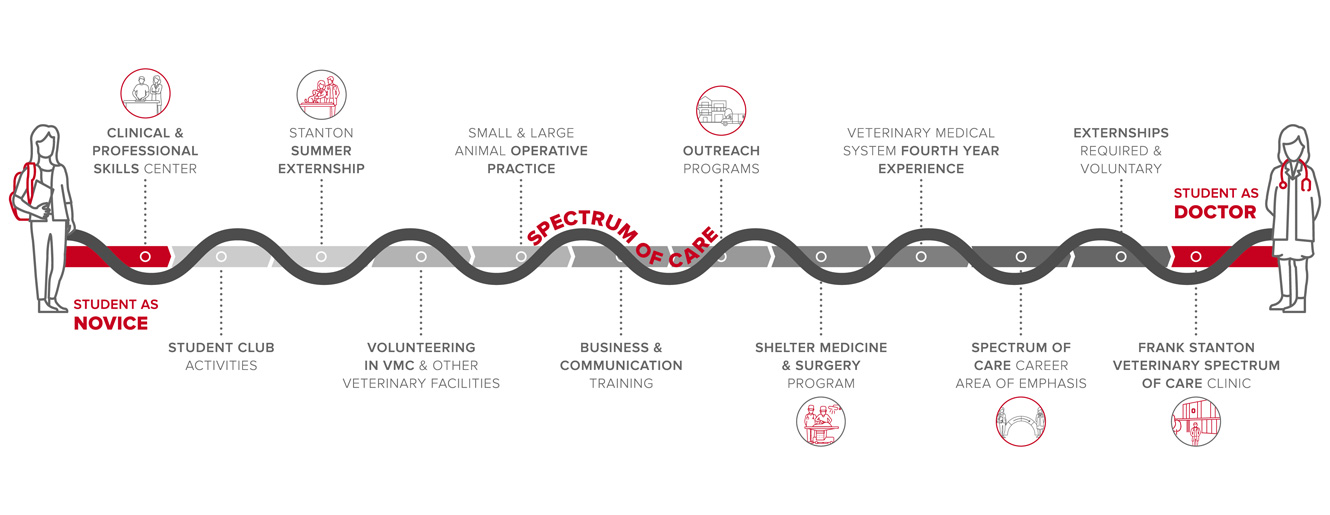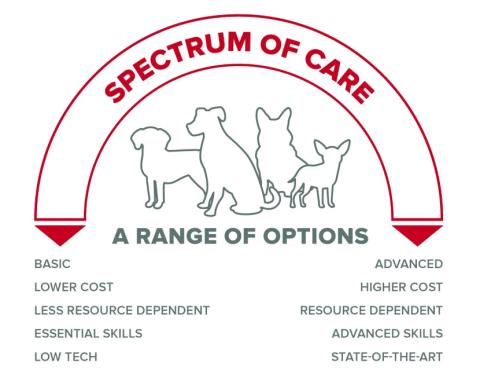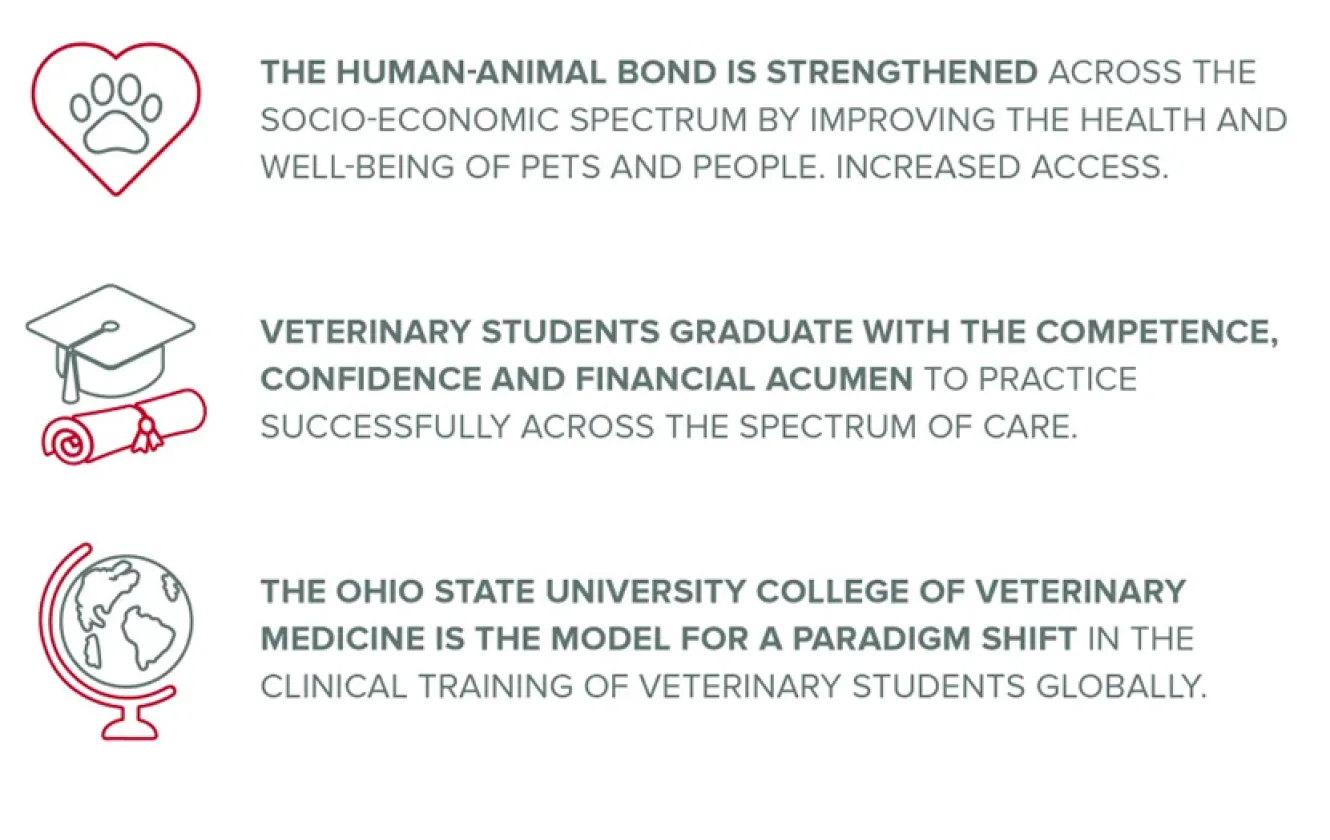From Novice to Doctor
Through immersive, hands-on training, students develop broad expertise as they progress from novice to doctor, honing skills through simulations, clinical experience, client interactions, and running an actual practice. This approach helps them develop the confidence and competence they need to practice more broadly across the spectrum of care, offering a wider variety of treatment options to pet owners.

Enhancing the bond between humans and animals

The Spectrum of Care
Every day, veterinarians work towards ensuring the health and well-being of animals by providing accessible, effective and affordable veterinary care to as many pet owners as possible. They have a range of care options available, covering various diagnostic and treatment options for their patients. The choice of care option depends on various factors, including the client's cultural experiences, socioeconomic status, standards of care, and the veterinarian's expertise.
The Preparing for Excellence program advances the practice of veterinary medicine by ensuring that graduate veterinarians are confident, competent, and prepared to practice broadly across the spectrum of care, ranging from technologically advanced and expensive options to less costly ones.
Creating Practice Ready Veterinarians
Program Components
The Preparing for Excellence program provides students with hands-on learning opportunities that develop and refine essential clinical and professional skills, allowing them to provide a wide variety of diagnostic and treatment options for their patients, leading to improved patient outcomes. By offering immersive hands-on training throughout the program, students develop broad expertise as they progress toward graduation, honing skills through simulations, treatment, client interactions, and running an actual practice. Future veterinarians develop the confidence and competence they need to practice more broadly across the spectrum of care.
Students learn clinical, technical and communication skills from the beginning of their education with regular and continual practice, coaching and feedback in a low-risk controlled setting. Combining audiovisual and lecture capture technology with high and low fidelity models and simulators, the center is a realistic training environment that imitates actual client/patient interactions. Through this approach, they can develop a growth mindset and seek to gain the confidence they need to thrive in new situations. Gaining skills, knowledge and confidence early in the program and learning how to be open to feedback are key to being successful throughout their veterinary career.
Faculty and local practitioners are truly invested in this hands-on education and are committed to creating graduates who are immediately ready to begin their careers. After students have been taught hands-on skills they are tested in an equally hands-on method. Students are re-taught and tested until they are confident and competent in their abilities. Early introduction of skills, repetitive practice with feedback on performance, and critical review of competence are required to ensure learners are successful.
dels.
In this program, students are placed in private spectrum of care practices to combine intensive educational training with real-world clinical practice experience serving under served populations. The program emphasizes the traditional role of the general practitioner. Through observation and performance, students are prepared to work with clients and pets at various socioeconomic levels, including underserved populations of companion canines and other small animals in need of care. Students in the program receive a 10-week stipend and compensation for travel and lodging.
The early exposure to hands-on veterinary practice is transformational. As students gain knowledge and skills, they become more confident and feel invested as part of the veterinary care team. Once students understand their own potential, their learning experience is even more valued and they commonly report the program as a life-changing and transformational experience.
By providing wellness care and basic medicine services to underserved animals and their pet parents in our community, students interact with diverse populations, better preparing them for general practice veterinary careers, in which compassion and interpersonal skills are as essential as medical knowledge. Students learn spectrum of care principles when working with underserved animals by providing high-quality medical assessments and wellness care to dogs and cats while working with limited resources. Students practice low-stress animal handling skills, veterinary technical skills, verbal, and written communication skills and working as part of a team to provide medical care to a patient.
The Veterinary Outreach Medicine Program is one of the veterinary students’ favorite experiences. The program has strong support from administration and is funded through generous private gifts. There are many ways for students to become involved, and the program continues to grow and evolve to increase service to underserved people and pets in Franklin County and beyond. In addition to enhancing their clinical and communications skills, it helps to raise social awareness, build cultural competencies, and instill civic responsibility in our students.
The shelter medicine and surgery rotation are core clinical programs taken by every fourth-year veterinary student. The entire rotation is conducted offsite and in partnership with Columbus Humane. Students work in pairs as the primary surgeons and/or anesthetist on spay and neuter procedures for canine, feline, rabbit and potbelly pig patients, as well as performing other procedures such as dental extractions, mass removals, eyelid surgeries, limb amputations, hernia repairs and other common soft tissue procedures. Two faculty members oversee, supervise and support students regarding questions, concerns, or correction of complications.
Students also perform procedures in a shelter setting with basic surgical instruments. Students have the opportunity to make decisions while also having the support of clinical faculty with private practice experience who are able to provide in-the-moment feedback on techniques and skills while helping new surgeons become more comfortable in that role.
General practice is particularly challenging for new veterinary graduates because it requires comfort with ambiguity and this is normally difficult to foster during training, especially with high achieving learners who tend to be perfectionist by nature. Students have a unique opportunity in their program to broaden their skill set and confidence by intentionally working in a small animal general practice that has been identified as a model of spectrum of care.
These practice placements focus on clinics offering a broad range of diagnostic and treatment options in first opinion environments with clients from across the range of financial means. Students learn firsthand that there are a variety of choices that can be offered with regards to acceptable care for the pets that are presented. This program endeavors to instill the tools and confidence students need to rise to the challenge of being innovative in practice.
These unique placement settings provide students with exposure to the challenges and solutions that are different than those of a tertiary referral setting. Students are able to gain exposure to daily decision-making in general practice by being put into the “driver’s seat,” so they can learn to manage clients, the staff and patients. The supervising doctors are primarily in a coaching role to offer support and advice as students are observed to consider their available options and to effectively counsel clients.
Final year students become practice-ready by taking the lead role in providing veterinary care during their rotation through the Frank Stanton Veterinary Spectrum of Care Clinic. They manage patients across the entire spectrum of care, in addition to fine-tuning clinical and business management skills and building the confidence and competence needed to be successful primary care practitioners.
Alongside the final year “students as doctors”, the year 1 to 3 students join the workforce to learn the art of veterinary practice from the “ground up.” Students participate in clinic duties like patient care, client care and assisting with diagnosis and treatment as they also learn in their other classes. This alignment with early clinical experience makes their other classes richer and more meaningful and exposes them to the expectations and realities of practice right from the start.
All students are trained to practice broadly across the spectrum of care in this setting, becoming veterinarians who are confident and competent to provide a full range of treatment options, thus producing positive pet and client outcomes.
Expanding care options for pet owners
Frank Stanton's Vision
The College of Veterinary Medicine's vision of providing an innovative and immersive approach to veterinary medicine is in large part inspired by the mission and generosity of the Stanton Foundation. Dr. Frank Stanton, an alumnus of The Ohio State University and president of CBS from 1946-1971, turned to the College of Veterinary Medicine in the mid-1930s when his beloved Boston Terrier needed medical care.
His experience created a lasting bond with the college that continues to have an impact many decades later. To support areas where he was unable to complete his charitable intentions during his lifetime, the Stanton Foundation was created and has been instrumental in positioning The Ohio State University College of Veterinary Medicine to build preeminence in the way we educate general practitioners, including the creation of the Frank Stanton Veterinary Spectrum of Care Clinic, which will open in 2021. Frank Stanton’s philanthropic love for canines enabled the college to take transformational leaps forward in preparing students to graduate ready to practice broadly and successfully across the spectrum of care.
